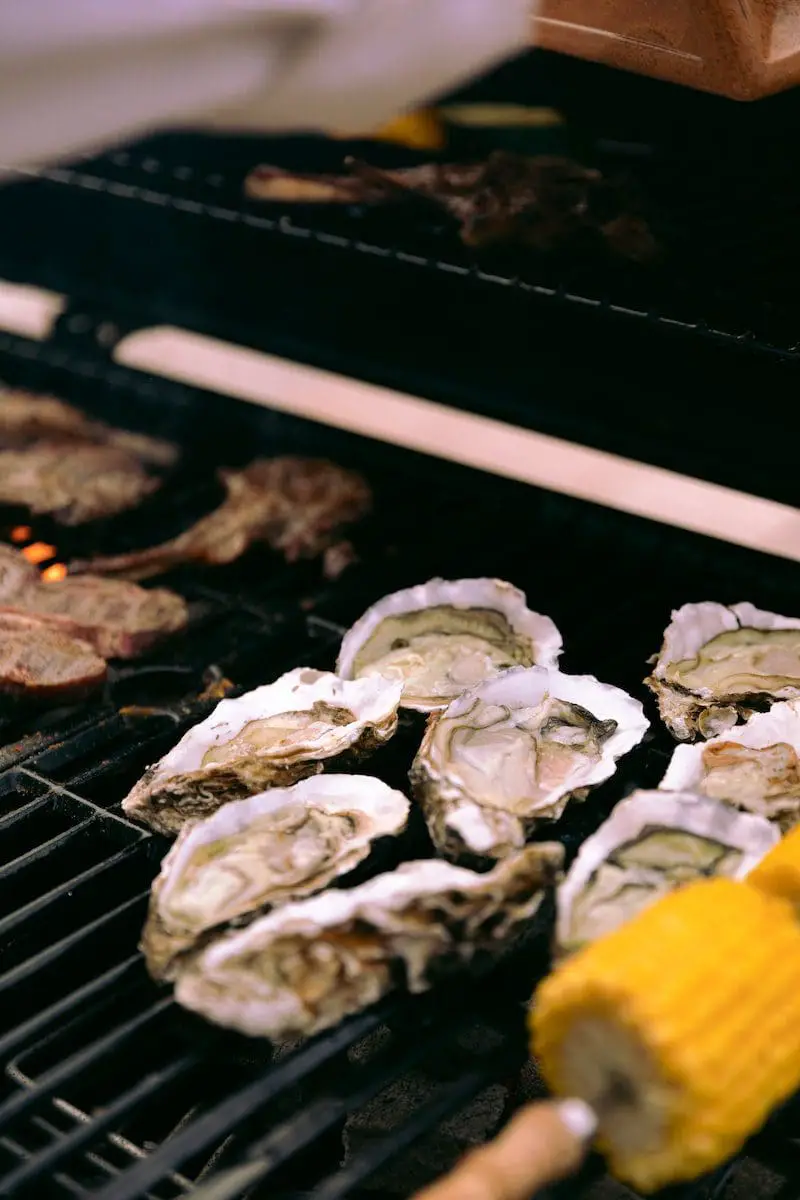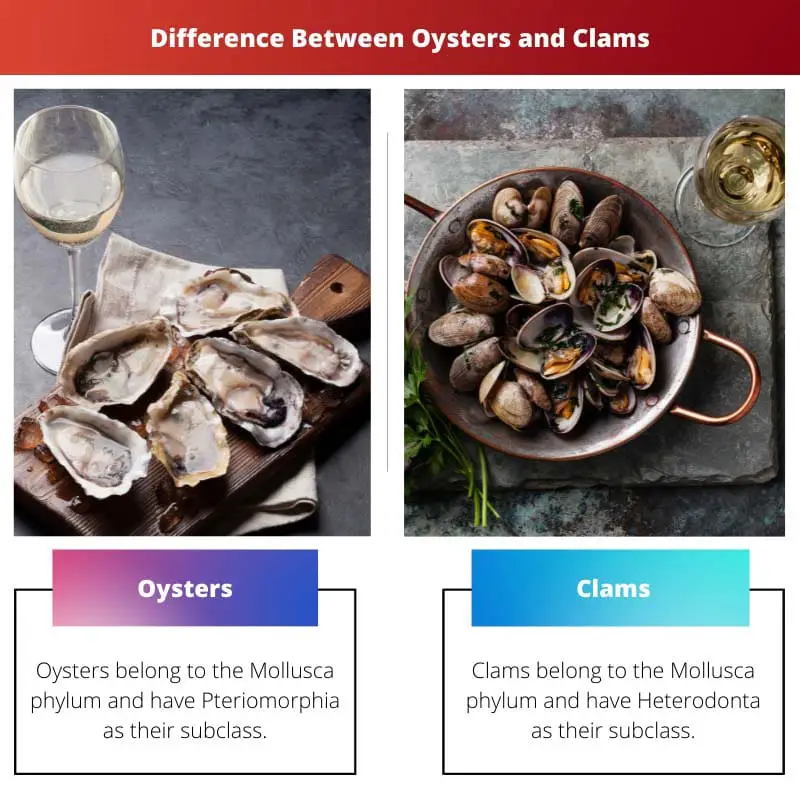Seafood has always been a delicacy for people living by the seashores. They particularly enjoy the taste of shellfish and mollusks like oysters and clams.
Mollusks make up about 23% of all marine organisms. They include organisms like snails, octopuses, oysters, and clams.
However, when it comes to seafood, people confuse oysters and clams as the same, although they are not.
Key Takeaways
- Oysters and clams are both bivalve mollusks, but they belong to different families: oysters belong to the family Ostreidae, while clams belong to various families, such as Veneridae and Myidae.
- Oysters have irregularly shaped shells that are rough and thick, while clams have symmetrical, smooth, and rounded shells.
- Oysters are primarily filter feeders that consume plankton and other small particles from the water. At the same time, clams are mainly burrowers that live in the sand or mud and filter feed on detritus and organic matter.
Oysters vs. Clams
The difference between oysters and clams is that oysters have a rough shell and a pearl inside, whereas clams have a smooth surface and can only be used for eating.

Oysters are mollusks residing in saline water. They are consumed as seafood, and some of them also harbor pearls.
Clams are mollusks residing in fresh and saline water both. Their primary consumption is only in the form of seafood.
In ancient times, they were also used as coins and jewelry.
Comparison Table
| Parameter Of Comparison | Oysters | Clams |
|---|---|---|
| Classification | Oysters belong to the Mollusca phylum and have Pteriomorphia as their subclass. | Clams belong to the Mollusca phylum and have Heterodonta as their subclass. |
| Shell Structure | The shell of an oyster is rough and rich in calcium content. | The shell of a clam is hard and lustrous. |
| Preferred Residence | Oysters prefer brackish marine waters. | Clams prefer freshwater bodies. |
| Motion | Oysters are born with a foot that helps them to stick at a particular place and then disappears. | Clams have a muscular foot for movement. They also depend on water currents for their training. |
| Nutritional Richness | Oysters are rich in proteins, copper, zinc, riboflavin, Vitamin D, and B12. | Clams are rich in proteins, iron, zinc, selenium, and vitamin B12. |
What are Oysters?
Oyster is a popular seafood. The organism belongs to the phylum mollusk with class bivalves. Its subclass is Pteriomorphia.
They prefer saltwater and have rough shells rich in calcium. A group of oysters is termed an Oyster Reef.
Pearl oysters enclose pearls within their shells.
Their gender is uncertain as they have both sperm and eggs. They are born as males, and after one year, they convert into females.
They feed on plankton and other oceanic residues. However, they are fed on by crabs, starfish, and humans.
They provide several ecological benefits. They help in the filtration of water, maintenance of the nutrient cycle, and prevention of eutrophication.
However, they are affected by many diseases like Dermo and Multinucleated Sphere X. Also, they harbor bacteria like Vibrio vulnificus that cause Gastroenteritis in humans.

What are Clams?
Clam is a tasty seafood. The organism belongs to the phylum mollusk with class bivalves.
Its subclass is Heterodonta.
They prefer freshwater and have shiny shells. They burrow in the seafloor, and their age may vary from 1 to 500 years.
They are dioecious, which means that they have separate genders. When the conditions are favorable, they reproduce by releasing many sperms and eggs in the ocean.
They feed on plankton, algae, and fish excrement. However, they are fed on by walruses, seals, and humans.
They have several associated ecological benefits. They filter water, remove Nitrogen from water, prevent algal blooms, and help in carbon sequestration from the atmosphere.
However, they are affected by many diseases like Dermo and Quahog Parasite Unknown ( QPX). Also, they harbor bacteria like Chlamydiales and Rickettsiales.

Main Differences Between Oysters and Clams
Oysters and clams are mollusks. They have varied shell structures and functions.
They both are enjoyed as seafood, and have several differences between them.
The main differences between the two are :
- Oysters have rough, irregular shells, whereas clams have hard, lustrous surfaces.
- Oysters prefer saline water for breeding, whereas clams prefer freshwater.
- The gender of the oysters is uncertain as they behave as both males and females during specific times. On the other hand, the gender of most clams is definite.
- Oysters indulge in minimal movement throughout their lives, and they have a foot that disappears as soon as they get attached to a surface. On the other hand, clams have a muscular foot for movement.
- Animals like crabs and starfish feed on oysters, whereas walruses and seals feed on clams.

- https://www.journals.uchicago.edu/doi/pdfplus/10.2307/1538972
- https://www.cabdirect.org/cabdirect/abstract/19531400195





It’s interesting to learn about the ecological benefits provided by oysters and clams.
I agree, it shows how vital they are in the marine ecosystem.
Absolutely, it’s more than just about the differences between the two.
I appreciate how the article delves into the ecological benefits and associated diseases related to oysters and clams.
Yes, it’s quite comprehensive in its coverage of these aspects.
I didn’t know that clams could live up to 500 years! The article is truly enlightening.
Indeed, the lifespan of clams is an intriguing aspect to learn about.
The detailed comparison table is extremely helpful in understanding the key differences.
Agreed, it provides a clear overview of the contrasting features.
Absolutely, the nutritional richness comparison is especially insightful.
I wasn’t aware of how oysters and clams differ. This is very helpful information.
Actually, I thought they were pretty similar before reading this article.
Indeed, the article provides a comprehensive comparison between the two.
This article explains the nutritional richness of oysters and clams very well.
I completely agree, the comparison is quite enlightening.
The article presents valuable information about the motion and preferred residence of oysters and clams.
Completely agree, it’s an enlightening read on the topic.
Definitely, I’ve learned a lot from this article.
This article sheds light on the historical significance of oysters and clams as well.
The article serves as a great resource for understanding the various aspects of oysters and clams.
Absolutely, it’s not just about the present but also the past significance of these mollusks.
Great article about the difference between oysters and clams, very informative!
I totally agree with you, this article explains it very clearly.
The article effectively distinguishes the main differences between oysters and clams.
Absolutely, the article is quite comprehensive and well-researched.
It does provide a clear understanding of their contrasting characteristics.